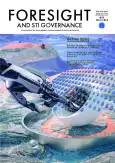Volume 10, Nº 2 (2016)
- Ano: 2016
- Artigos: 5
- URL: https://bakhtiniada.ru/1995-459X/issue/view/23795
STRATEGIES
Robotics: Breakthrough Technologies, Innovation, Intellectual Property
Resumo
 7-27
7-27


INNOVATION
Determinants of Regional Innovation in Russia: Are People or Capital More Important?
Resumo
Spending on innovation increased annually in the 2000s in Russias regions, but innovation productivity varies greatly between regions. In the current climate of sanctions between Russia and Western countries and limitations on international technology transfer, there is a growing need to analyse the factors influencing regional innovation. Previous empirical studies using a knowledge production function approach have found that the main factor of the growth of regional innovation is increasing spending on research and development (RD).Our econometric analyses show that the quality of human capital, a product of the number of economically active urban citizens with a higher education (the so-called creative class) has the greatest influence on the number of potentially commercializable patents.Other significant factors were buying equipment, which indicates a high rate of wear and tear of Russian machinery, and spending on basic research. The centre-periphery structure of Russias innovation system favours the migration of highly qualified researchers to leading regions, which weakens the potential of the donor regions. However, at the same time, we see significantly fewer limitations on knowledge spillovers in the form of patents and in this case proximity to the centres is a positive factor.
 29-42
29-42


SCIENCE
Determinants of Research Productivity: An Individual-level Lens
Resumo
The continuous growth of investment in RD in Russia and the world increases the demand for optimal allocation of public funds to support the most productive scientific performers. These are, however, hard to conceptualize and measure. First, we need to consider the nature of research activity itself and, second, we need to evaluate a number of factors that influence such activities at the national, institutional and individual levels. One of the key issues is motivation of academic personnel, who are considered to be the main producers of new knowledge. Therefore, it is necessary to analyse the employment characteristics of researchers, and develop adequate mechanisms to facilitate their scientific productivity.This paper aims to examine determinants of publication activity among doctorate holders employed in an academic sector in Russia. Data for the analysis was derived from a survey on the labour market for highly qualified RD personnel conducted in 2010 by the HSE, within the framework of the OECD / UNESCO Institute for Statistics /Eurostat international project on Careers of Doctorate Holders (CDH). With the use of regression analysis, we assess the effects of scientific capital, international cooperation, employment, and socio-demographic characteristics of researchers on their productivity, which is measured through their total publication output as well as through the number of papers in peer-reviewed academic journals.The differences between factors were assessed for two generations of researchers below 40 years old, and above. It was shown that the quality of scientific capital, measured through diversity of research experience, has a stronger impact on research productivity, rather than the age or other socio-demographic characteristics of doctorate holders. It was also demonstrated that direct economic stimuli and actual research productivity of researchers are weakly correlated. Consequently, we identified that a potentially winning strategy for universities and research institutions that want to improve their performance indicators would be to provide younger scholars with wider opportunities for professional growth, including intense global cooperation in the professional community.
 44-56
44-56


MASTER CLASS
Social and Business Innovations: Are Common Measurement Approaches Possible?
Resumo
 58-80
58-80


Electronic ‘Knowledge Factories’ versus Micro-environment of Innovation: Who Will Win?
Resumo
 81-91
81-91










